Abstract
Objectives: In Ethiopia, western modern education has been introduced in 1908, though there has been traditional education
starting from the entrance of Christianity in Ethiopia in the sixth century. Currently, there are thousands of government
and private schools in the country. The objective of this study is to identify who scores well in anatomy in the university;
students coming from government or private schools?
Methods: A cross-sectional study design was used to assess the effect of high school background on medical students’ performance
in anatomy among 120 randomly selected students at Bahir Dar University College of Medicine and Health Sciences.
Results: Anatomy is given for medical students as separate course in regional approach for ten months after they complete premed
courses as five hours lecture and one hour practical session per week. Students than take an exam with theoretical and
practical parts, after completion of each region. Out of 120 randomly selected students about 64% joined the university from
government schools and the rest were from private schools. From the government school group, only 17% of the students
scored low. However, out of the total private school students 40% were low scorers. There was a statistically significant correlation
between school background and medical student performance in anatomy (p=0.007). The odds of private school students
performance in anatomy was 3.22 times lower than those of government school students (p=0.007)
Conclusion: Students graduated from government high schools perform better in academics than students graduated from
private schools.
Keywords
References
- 1. Banu LA, Shomsher AM. Views of teachers regarding course contents of anatomy in post graduate MD internal medicine curriculum. Bangladesh Journal of Anatomy 2009;7:55–61. 2. Iyawe VI, Ebojele FO. Performance of 300 level medical students of the University of Benin in the second professional MBBS degree examinations: a ten years retrospective study. Journal of Medicine and Biomedical Research 2016;15:49–54. 3. Esom EA, Eze JN, Ozoemena OFN, Ezepue UF. Factors that affect medical students’ performance in anatomy in the University of Nigeria. Orient Journal of Medicine 2010;1:6– 10. 4. Pal S, Pal M. Factors affecting the performance of students in anatomy: a case study. Indian Journal of Applied Research 2013;3: 360–1. 5. Maslov Kruzicevic S, Barisic KJ, Banozic A, Esteban CD, Sapunar D, Puljak L. Predictors of attrition and academic success of medical students: a 30-year retrospective study. PLoS One 2012:7: e39144. 6. Yates J, James D. Risk factors at medical school for subsequent professional misconduct: multicentre retrospective case-control study. BMJ 2010;340:c2040. 7. Win R, Miller PW. The effects of individual and school factors on university students’ academic performance. Australian Economic Review 2005;38:1–8. 8. Pal Y, Patel T. A study of educational achievement of government and non government school students in context to area. International Education and Research Journal 2016;2:139–42. 9. Goyal S, Pandey P. How do government and private schools differ? [Available on the internet] [http://2010.economicsofeducation.com/ user/pdfsesiones/042.pdf] 10. Mancebon MJ, Calero J, Choi A, Ximénez-de-Embún DP. The efficiency of public and publicly subsidized high schools in Spain: evidence from PISA-2006. J Oper Res Soc 2012;63:1516–33.
Abstract
References
- 1. Banu LA, Shomsher AM. Views of teachers regarding course contents of anatomy in post graduate MD internal medicine curriculum. Bangladesh Journal of Anatomy 2009;7:55–61. 2. Iyawe VI, Ebojele FO. Performance of 300 level medical students of the University of Benin in the second professional MBBS degree examinations: a ten years retrospective study. Journal of Medicine and Biomedical Research 2016;15:49–54. 3. Esom EA, Eze JN, Ozoemena OFN, Ezepue UF. Factors that affect medical students’ performance in anatomy in the University of Nigeria. Orient Journal of Medicine 2010;1:6– 10. 4. Pal S, Pal M. Factors affecting the performance of students in anatomy: a case study. Indian Journal of Applied Research 2013;3: 360–1. 5. Maslov Kruzicevic S, Barisic KJ, Banozic A, Esteban CD, Sapunar D, Puljak L. Predictors of attrition and academic success of medical students: a 30-year retrospective study. PLoS One 2012:7: e39144. 6. Yates J, James D. Risk factors at medical school for subsequent professional misconduct: multicentre retrospective case-control study. BMJ 2010;340:c2040. 7. Win R, Miller PW. The effects of individual and school factors on university students’ academic performance. Australian Economic Review 2005;38:1–8. 8. Pal Y, Patel T. A study of educational achievement of government and non government school students in context to area. International Education and Research Journal 2016;2:139–42. 9. Goyal S, Pandey P. How do government and private schools differ? [Available on the internet] [http://2010.economicsofeducation.com/ user/pdfsesiones/042.pdf] 10. Mancebon MJ, Calero J, Choi A, Ximénez-de-Embún DP. The efficiency of public and publicly subsidized high schools in Spain: evidence from PISA-2006. J Oper Res Soc 2012;63:1516–33.
Details
| Primary Language | English |
|---|---|
| Subjects | Health Care Administration |
| Journal Section | Teaching Anatomy |
| Authors | |
| Publication Date | August 31, 2019 |
| Published in Issue | Year 2019 Volume: 13 Issue: 2 |
Cite
Anatomy is the official journal of Turkish Society of Anatomy and Clinical Anatomy (TSACA).


